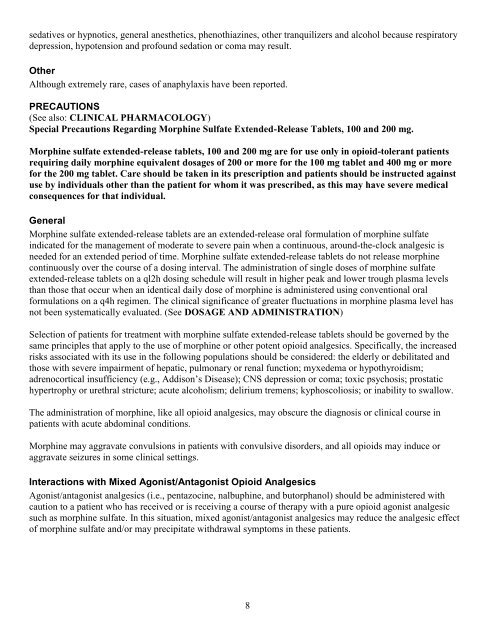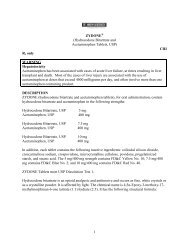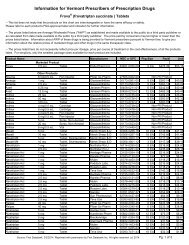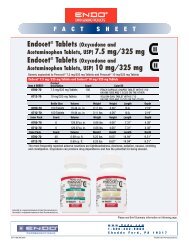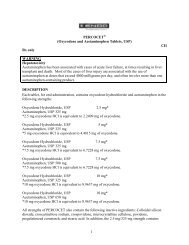Morphine Sulfate Extended-Release Tablets - Endo Pharmaceuticals
Morphine Sulfate Extended-Release Tablets - Endo Pharmaceuticals
Morphine Sulfate Extended-Release Tablets - Endo Pharmaceuticals
You also want an ePaper? Increase the reach of your titles
YUMPU automatically turns print PDFs into web optimized ePapers that Google loves.
sedatives or hypnotics, general anesthetics, phenothiazines, other tranquilizers and alcohol because respiratory<br />
depression, hypotension and profound sedation or coma may result.<br />
Other<br />
Although extremely rare, cases of anaphylaxis have been reported.<br />
PRECAUTIONS<br />
(See also: CLINICAL PHARMACOLOGY)<br />
Special Precautions Regarding <strong>Morphine</strong> <strong>Sulfate</strong> <strong>Extended</strong>-<strong>Release</strong> <strong>Tablets</strong>, 100 and 200 mg.<br />
<strong>Morphine</strong> sulfate extended-release tablets, 100 and 200 mg are for use only in opioid-tolerant patients<br />
requiring daily morphine equivalent dosages of 200 or more for the 100 mg tablet and 400 mg or more<br />
for the 200 mg tablet. Care should be taken in its prescription and patients should be instructed against<br />
use by individuals other than the patient for whom it was prescribed, as this may have severe medical<br />
consequences for that individual.<br />
General<br />
<strong>Morphine</strong> sulfate extended-release tablets are an extended-release oral formulation of morphine sulfate<br />
indicated for the management of moderate to severe pain when a continuous, around-the-clock analgesic is<br />
needed for an extended period of time. <strong>Morphine</strong> sulfate extended-release tablets do not release morphine<br />
continuously over the course of a dosing interval. The administration of single doses of morphine sulfate<br />
extended-release tablets on a ql2h dosing schedule will result in higher peak and lower trough plasma levels<br />
than those that occur when an identical daily dose of morphine is administered using conventional oral<br />
formulations on a q4h regimen. The clinical significance of greater fluctuations in morphine plasma level has<br />
not been systematically evaluated. (See DOSAGE AND ADMINISTRATION)<br />
Selection of patients for treatment with morphine sulfate extended-release tablets should be governed by the<br />
same principles that apply to the use of morphine or other potent opioid analgesics. Specifically, the increased<br />
risks associated with its use in the following populations should be considered: the elderly or debilitated and<br />
those with severe impairment of hepatic, pulmonary or renal function; myxedema or hypothyroidism;<br />
adrenocortical insufficiency (e.g., Addison’s Disease); CNS depression or coma; toxic psychosis; prostatic<br />
hypertrophy or urethral stricture; acute alcoholism; delirium tremens; kyphoscoliosis; or inability to swallow.<br />
The administration of morphine, like all opioid analgesics, may obscure the diagnosis or clinical course in<br />
patients with acute abdominal conditions.<br />
<strong>Morphine</strong> may aggravate convulsions in patients with convulsive disorders, and all opioids may induce or<br />
aggravate seizures in some clinical settings.<br />
Interactions with Mixed Agonist/Antagonist Opioid Analgesics<br />
Agonist/antagonist analgesics (i.e., pentazocine, nalbuphine, and butorphanol) should be administered with<br />
caution to a patient who has received or is receiving a course of therapy with a pure opioid agonist analgesic<br />
such as morphine sulfate. In this situation, mixed agonist/antagonist analgesics may reduce the analgesic effect<br />
of morphine sulfate and/or may precipitate withdrawal symptoms in these patients.<br />
8


